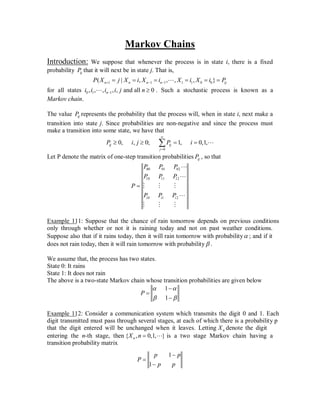This document introduces Markov chains and provides examples to illustrate key concepts. Markov chains model stochastic processes where the probability of transitioning to the next state depends only on the current state, not on the process history. The document defines one-step and n-step transition probabilities and the Chapman-Kolmogorov equations for computing n-step probabilities. Examples include weather modeling, communication systems, and gambling.






![Adding the first 1i of these equations yields,
2 1
1 1
i
i
q q q
P P P
p p p
2 1
1 1
i
i
q q q
P P
p p p
If 1
q
p
, then
2 1
1
1
1
, 1
11
i
n
n
i
q
p x
P P x x x
q x
p
If 1
q
p
, then 1 1[1 1 1]i
i
P P iP
Thus,
1
1
1
, if 1
1 (2)
, if 1
i
i
q
p q
P
q p
P p
q
iP
p
Putting i = N in equation (2), we get,
1
1
1
, if 1
1 (3)
, if 1
N
N
q
p q
P
q p
P p
q
NP
p
Now, using the fact that 1NP in equation (3), we obtain that
If 1
q
p
, then
1
1
1
N
N
q
p
P P
q
p
1
1
1
N
q
p
P
q
p
If 1
q
p
, then 11 NP
1
1
P
N
***
These formulas are OK
even when p < q OR p> q OR p = q
***
Or, p = q = 1/2 Or, p == q (i.e., when winning chance = loosing chance.
example: fair coin toss => head=win, tail = loss
or vice versa)
Partial proof
may appear
in exam !!!](https://image.slidesharecdn.com/08markovchain-191203122915/85/Markov-chain-7-320.jpg)
